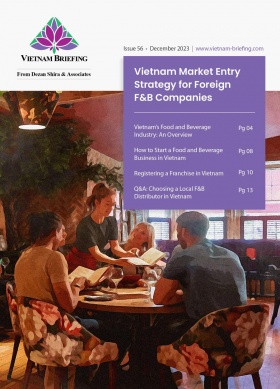Vietnam Edible Oil Market for Foreign Firms
The edible oil market in Vietnam is growing rapidly. In this light, we analyze the opportunities for foreign investors.
According to data from Statista, the edible oil market in Vietnam is estimated to grow annually by a CAGR of 7.29 percent between 2024 and 2028.
The rapid pace of urbanization in Vietnam, along with rising living standards and consumer awareness of the health benefits of quality cooking oils, has led to an increase in demand for edible oils in recent years.
Cooking oil use in Vietnam has grown by roughly 0.5 percent per year since 2017. This saw Vietnam become the 52nd biggest consumer of edible oils in 2021. With this in mind, the Vietnam Briefing looks at how the edible oils market in Vietnam is developing.
Growth drivers
Health-conscious consumers
Since the end of the COVID-19 pandemic, Vietnamese have been more interested in their health, with a growing interest in their personal nutrition. Cooking oil often contains vitamins A, D, E, and K and depending on the type can provide consumers with broad health benefits.
Food processing industry growth
The domestic food processing industry’s average annual growth rate between 2023 and 2027 is expected to come in at around 8.22 percent and this is driving up demand for cooking oil which is used in processing a range of foods.
In the production and processing plants of the food industry in Vietnam, cooking oil is considered an indispensable key ingredient in the production of fried foods. Furthermore, cooking oil is also utilized in the preparation of bread and cakes as it retains moisture making pastries softer and smoother.
Opportunities
Imports
Vegetable oils popular among Vietnamese customers include palm oil (the major ingredient in vegetable oil), soybean oil, olive oil, sesame oil, peanut oil, sunflower oil, and canola oil. However, Vietnamese domestic firms generally only manufacture soybean oil, peanut oil, and sesame oil. These oils account for around 30 percent of market demand, while palm oil accounts for roughly 70 percent.
Because of the shortfall, Vietnam’s cooking oil sector must expand imports from overseas to fulfill local consumer demand. Notably, Malaysia and Indonesia are two countries that export substantial volumes of cooking oil to Vietnam. Foreign investors could benefit from this opportunity by supplying Vietnam with other types of oil not produced in the country.
Sustainability
Increasing awareness among Vietnamese consumers has required cooking oil products to be produced in an environmentally friendly manner.
Most cooking oil processing, manufacturing, and refining facilities in Vietnam still have significant constraints. Production lines utilizing outdated technology have resulted in poor product quality, resulting in a waste of both time and resources.
Upgrading the quality of local manufacturing facilities to be environmentally friendly could be another appealing investment opportunity. Investing in factories with contemporary technology and production equipment systems that do not harm the environment may be one of the keys to enhancing product quality and boosting output.
Key domestic players
Calofic Corporation
Cai Lan Vegetable Oil Company Limited (CALOFIC) is a joint venture between the Ministry of Industry and Trade’s Vietnam Vegetable Oil Industry Corporation (VOCARIMEX) and the Singapore-based Wilmar Group.
This joint venture began in 1996 with an initial investment of US$22 million, which was later expanded to US$261 million. The company accounted for 47.7 percent of the market in 2019. The firm produces and processes vegetable oil in Vietnam mostly from domestic raw resources.
Vocarimex
Vietnam Vegetable Oil Industry Corporation (VOCARIMEX) is a market leader in Vietnam’s vegetable oil sector. The corporation has currently created over 50 cooking oil product lines, with more than 90 percent of Vocarimex’s raw materials imported (mostly palm and soybean oil).
Vocarimex currently produces more than 81 percent of total domestic refined oil output, accounting for more than 85 percent of the domestic vegetable oil market.
Tuong An Vegetable Oil
The company was established in 1977 and now accounts for around 20 percent of the Vietnamese cooking oil market. Tuong An Vegetable Oil is currently a leading respectable entity in the manufacture and sale of plant-based oils and fats.
In 2016, KIDO Group finalized the acquisition of 65 percent of Tuong An. Since then, Tuong An has separated its components into two categories: 100 percent imported raw materials such as palm oil, palm stearin, and soybean oil (crude oil), and locally produced ingredients like peanut oil, and coconut oil.
Looking forward
A lack of supply and a shift in consumer awareness regarding cooking oil has created excellent prospects for foreign investors to enter this market in Vietnam.
For more information on how to go to market in Vietnam, contact the business advisory experts at Dezan Shira and Associates.
About Us
Vietnam Briefing is published by Asia Briefing, a subsidiary of Dezan Shira & Associates. We produce material for foreign investors throughout Asia, including ASEAN, China, and India. For editorial matters, contact us here and for a complimentary subscription to our products, please click here.
Dezan Shira & Associates provide business intelligence, due diligence, legal, tax and advisory services throughout the Vietnam and the Asian region. We maintain offices in Hanoi and Ho Chi Minh City, as well as throughout China, South-East Asia, Dubai, and India. For assistance with investments into Vietnam, please contact us at vietnam@dezshira.com or visit us at www.dezshira.com.
- Previous Article Vietnam-Austria Trade Overview
- Next Article Planning for Uncertainty: Global Staffing Solutions to Facilitate Your Vietnam Market Entry







